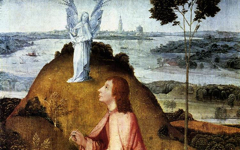Bosch’s St. John in the Wilderness (1504-5)
This painting known as St John the Baptist in the Wilderness could easily be of St. Jerome if there were a lion as his attribute near the thoughtful figure instead of a lamb. The Baptist adopts the pose more commonly associated with Jerome, a popular figure in the Renaissance.
Click next thumbnail to continue
Jerome was an early Christian writer who, like St. John, went out into the desert to think and meditate. Both stories are an allegory for how esoteric thinkers should withdraw into themselves to contemplate their own minds without outside distraction. Thus John, and to a greater extent Jerome, have often been used to represent the artist in contemplation, in the process of conceiving his image. Here, in this example by Bosch, St John puts his head on his hand in a pose that many artists adopt in their own self-portraits, or have used in portraits of other artists. Dürer, another Northern painter, had portrayed himself, head on hand, a few years earlier.
Click next thumbnail to continue

Left: Detail of Bosch's St. John in the Wilderness
Right: Self-portrait detail from St. John on Patmos
Click image to enlarge.
To make the self-reference clearer to later artists, Bosch gave St John a long, thin nose like his own. Many of the facial similarities between artists and their figures have not been seen because literalists assumed that the different characters had different faces. Only when you know in advance that “every painter paints himself” do the similarities become more significant, visible and meaningful.
Click next thumbnail to continue

Left: Detail of Bosch's St. John in the Wilderness
Right: Two diagrams of the eye
Click image to enlarge.
In this example two open eggshells – one large, one small - resemble larger-than-life eyeballs while the plants supporting them recall what we would now name "optical nerves". Bosch, it appears, was familiar with the head's anatomy, as Michelangelo and Leonardo certainly were around the same time. Thus he seems to convey that he himself as St. John is inside his own mind, behind his eye-balls. With his eyes as egg-shells, they may have "conceived" the image as well.
Click next thumbnail to continue
If, therefore, we are looking at the fusion of an imaginary garden with the inside of a human head with stalks and tendrils as nerves and synapses, then a third, higher, eyeball (at left) should represent the inner eye of Bosch's imagination. It appears to have penetrated a horizontal leaf below which strangely resembles the surface of a pond with splashing water. Using flat water to signify the surface of his mind, the third "eyeball" is on the other side in a different reality, the inner eye of imagination. True artists always have three "eyes": left, right and inner.
See conclusion below
A second painting, the pair to this one, is of a different St. John, the writer of Revelations. Painted at the same time, and of similar size, it is also a depiction of the saint behind his eye because he literally painted a giant eyeball on the other side of the panel.
There have been many different interpretations of Bosch's pictures but if we are correct that the vast majority of great masters portray their own minds then Bosch must have done so too. Thus just as Michelangelo portrayed one half of a cerebral cortex in The Creation of Adam, a kidney in God Separating the Waters from the Elements and an optical system behind his "self-portrait" as Jonah facing the entrance to the Sistine Chapel, Bosch has done likewise. Given a similar interpretation of its pair, there now can be little doubt that Bosch has turned the anatomical parts of a human head into the contents of a magical garden.
More Works by Bosch
Notes:
Original Publication Date on EPPH: 08 Jun 2011. | Updated: 0. © Simon Abrahams. Articles on this site are the copyright of Simon Abrahams. To use copyrighted material in print or other media for purposes beyond 'fair use', you must obtain permission from the copyright owner. Websites may link to this page without permission (please do) but may not reproduce the material on their own site without crediting Simon Abrahams and EPPH.




